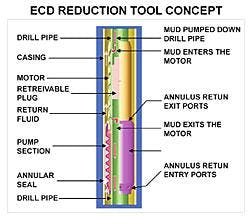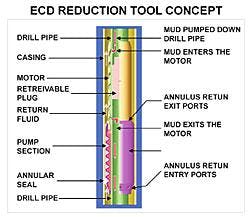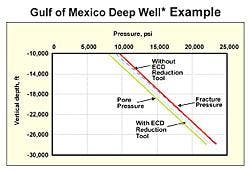New tool addresses ECD problem
By William Furlow
Editor-in-Chief
Anew tool reduces frictional circulating pressures in the annulus to ease exten-ded reach and other critical underbal-anced drilling operations. Literally a key sticking point in extended reach drilling is the ability to circulate mud and cuttings out of the hole while drilling. Because of the angle, it is difficult to get uniform circulation of fluid and cuttings up the annulus. It is common in such operations to have barite sag and other problems that make hole cleaning inefficient. This problem is magnified in deepwater operations, where the extended mud column puts tremendous weight on the formation. In these cases, the margin between pore pressure and fracture pressure is very close. Attempts to increase mud weight to drive cuttings out of the hole can easily result in a lost circulation event.
For drilling programs that include an underbalanced section, the risk of lost circulation is further reduced. The key benefit of drilling underbalanced is avoiding any skin damage. This is accomplished by letting the reservoir flow while drilling is underway. The circulating pressure drives the cuttings and fluid, comprised of drilling fluids plus reservoir fluids that have influxed into the wellbore, back up the annulus. If the reservoir pressure is not sufficient to drive the fluids up the annulus and out of the hole, then it is likely the larger solids will sag out of the fluid column and cause skin damage.
For vertical or near vertical drilling operations, there is another consideration in deep-water. The pressure of the mud column can easily invade the shallow formations due to the very low fracture gradients that exist while drilling through these sections. This can cause lost circulation and require additional casing strings to be run, affecting the inner diameter of the final completion and the economics of the well.
ECD reduction tool
The equivalent circulating density (ECD) is the increased frictional pressure down hole needed to move the mud up the annulus. ECD is calculated by dividing the annular pressure loss by .052, dividing the result by the true vertical depth of the well, and adding the result to the mud weight. It is this increase in pressure that can lead to the problems described above. While it is often necessary to increase mud weight, the ECD must be controlled to avoid formation damage and prevent lost circulation.
To address this problem, Weatherford is working with BP to develop an ECD reduction tool. The idea is to relieve the increased downhole pressure that occurs when the static mud column begins to circulate or the weight of the mud is increased. The tool is a multi-stage turbine located in the drillstring and positioned inside the outer casing. It is driven by the fluid pressure of mud traveling down the drill string. The turbine action then pumps fluid and cuttings returning on the annulus side, reducing the ECD below the tool. This reduces the risk of a lost circulation event, makes hole cleaning in extended-reach wells more efficient, and allows the operator to drill through shallow water zones.
According to Gary Warren, president of Weatherford's Drilling and Intervention Services, BP has invested over $150,000 to co-develop this technology. The turbine itself was developed by a company called Rotech, which licensed the technology to Weatherford for this application. The primary driver for the development of this tool is extended reach and deepwater drilling, where torque and drag issues also hamper drilling efficiencies.
"That's where we felt like the ECD reduction tool would be effective," Warren said.
BP is interested in a larger "beefed-up" version of the tool that could be used in the riser string for more broad applications, Warren said. This is the goal of the BP project. Warren said the original idea for such a tool came out of the Petroline group, which Weatherford acquired in 1999. Such a tool fits well with the company's goal of de-commoditizing oilfield services. By enhancing the performance of its components, Warren said, Weatherford hopes to set itself apart. "That's really what's separating us as a company," he said.
While some service companies have put their focus on the informational aspects of the business, Warren said, "Weatherford looks at unique mechanical solutions to application issues."


